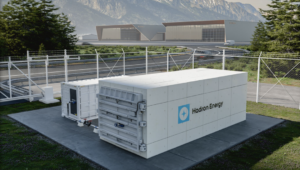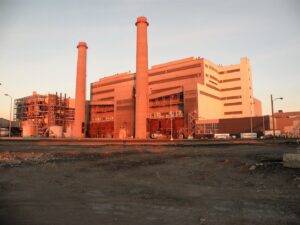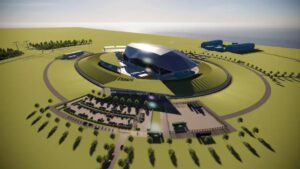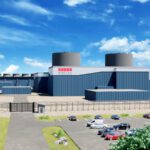
With billions of dollars pouring into the sector from power players like Google and Amazon, the data center industry is having a moment. But this surge in investment and interest has also brought up serious questions—particularly around how we are going to power these massive computing engines.
According to the U.S. Department of Energy, data centers are set to consume 12% of all U.S. energy by 2028, and filling the industry’s seemingly insatiable energy appetite has become the power challenge of our time. Moreover, the strain that data center expansion is set to place on the American power grid is unlike anything we have seen before. For example, in Virginia alone data center capacity is set to hit the equivalent of 9 million homes, triple the amount of households within the state.
COMMENTARY
To fill these needs, stakeholders from across the energy landscape have coalesced to try and crack the code. This has resulted in not only heightened interest around popular categories like renewables, but a renaissance for traditional assets as well—most notably nuclear.

With these daunting challenges staring the technology and energy sectors in the face, nuclear has rightfully captured the imagination of stakeholders. But what is exactly driving this resurgence and what are some of the prevailing trends that will shape the industry as we try to tackle this new and vexing frontier in our energy future?
Understanding the Nuclear Renaissance
While nuclear’s reemergence as a primary player in energy may have turned many heads, it isn’t necessarily surprising. For decades, technology heavyweights have felt the squeeze of how to build and power data centers that are capable of meeting expanding U.S. computing needs. Fortunately, over recent decades, stakeholders have largely been able to keep up with the pace of expansion as growth rates have remained relatively stable. The rapid boom in artificial intelligence (AI) has changed this dynamic entirely as technology stakeholders are now looking to build datac enters that produce loads of 1 GW, some 20 times larger than the biggest data centers of just 10 years ago, at warp speed.
POWER is at the forefront of coverage for data centers, particularly related to how technology companies will source the power needed to operate their artificial intelligence ventures. Read our POWER Primer, “Focus on Data Centers,” and register today to attend our inaugural Data Center POWER eXchange event, scheduled Oct. 28 in Denver, Colorado
Faced with trying to power these behemoth load additions while also meeting climate performance pressures, nuclear—and its potential for carbon-free power—has once again found itself at the center of energy solutions conversations.
However, while the reactivation of existing assets, such as Three Mile Island, have dominated headlines, what will truly be determinative of nuclear’s success is innovation in small modular reactor (SMR) and micro modular reactor (MMR) technology.
The Case for SMRs and MMRs
Licensing and go-to-market: One of the leading drawbacks against large-scale nuclear is the time it takes to even get to the point where plants can be built. Design certification, siting and construction permits and operating licenses can take years each to receive, and is why licensing alone for large scale plants can take upwards of a decade.
In addition to the headaches that this creates is the fact that these extended timelines make cost overruns commonplace and can present funding issues. SMRs and MMRs allow for much shorter licensing timelines. Unlike larger plants, SMRs can be licensed in 5-7 years, while timelines for MMRs can be licensed in 18 months. This creates much more certainty for datacenter stakeholders in terms of how long it will take to get these resources online and what the cost will be to do so.
Off-grid power and resiliency: Beyond on the logistical streamlining and go-to-market benefits of SMRs and MMRs is the potential for SMRs and MMRs to provide completely off-grid power, dramatically reducing the pressure on remote grids.
Wind and solar have been boons in terms of providing clean and remote power. However, even with the innovations in battery and storage technology, renewables still present challenges with intermittent supply. In 2024, for example, wind had a capacity factor of only 34%, while solar was at just 25%, according to the Energy Information Administration (EIA). In comparison, nuclear’s capacity factor stood at 92%. This type of “always on” reliability of supply has allowed nuclear to stand out from the pack.
Personnel and maintenance: Not only are large nuclear reactors costly and time consuming to build, they are also expensive to operate. At its peak, New York’s Indian Point Power Plant employed a staff of 1,000 full-time workers alone. Because of their pared down size, SMRs and MMRs will require a much more scaled down operational staff. That said, given a single SMR will be capable of providing 20 MW to 300 MW of electricity—several times that of a single MMR—and are more intricately designed and complex, the workforce needed to support operations will remain notable. This has turned attention towards MMRs in particular as their smaller operational footprints make them a more feasible option for power, particularly in remote areas.
Looking Ahead
Data centers have quickly gone from one of the quieter and often overlooked spaces of the energy landscape to arguably among its most visible in an incredibly short space of time. And with that, so have the unique energy hurdles and innovative solutions that surround them—chiefly among these being nuclear.
In addition to finding itself once again in the energy spotlight, nuclear is also undergoing its own rethink and innovation curve. And as the datacenter world continues to expand, we can expect nuclear to continue to evolve in tandem as the technology and energy industries look to solve our burgeoning computing power quandaries.
—Samuel Gibson is CEO and founder of Hadron Energy.










